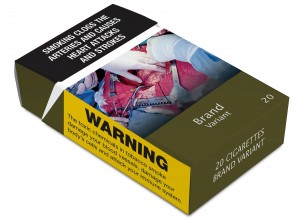Fresh hails the end of the “packet racket”

May 20 2016
CHILDREN will be given one less reason to start smoking as new laws come into force to introduce plain, standardised tobacco packaging.
Over the next year, out will go eye-catching, colourful cigarette boxes and in will come drab green packages with larger health warnings and a new set of graphic images showing the harm of smoking.
From 20th May 2016, all tobacco products manufactured for sale in the UK must comply with the new laws. There is a one year transitional period for the sell-through of old stock and from May 2017 all tobacco products on sale in the UK must comply with these regulations.
To see the effects of attractive packaging watch a short video produced by Fresh on our Youtube channel.
Ailsa Rutter, Director of Fresh, said: “This is a momentous step which will make smoking history for more children in our region and across the country.
“Hundreds of children start smoking every day and for far too long, tobacco companies have gift-wrapped their poisonous, killer products with bright colours that disguise the death and disease smoking causes.
“While tobacco companies have campaigned hard to stop this happening, more children have got hooked on smoking and more families will have had to say a last goodbye to someone who they love who is suffering from a smoking related disease.”
Councillor Nick Forbes, Chair of the North East’s Making Smoking History Partnership and Leader of Newcastle City Council, said: “For decades we have seen tobacco companies promote their harmful addictive products in vibrant packaging that makes them more enticing to teenagers and young people. This has been one of the scandals of the 20th century.
“Local authorities play a leading role in public health, and councils in the North East are working hard to reduce smoking and make smoking history for more children and more families. Tobacco smoking is still our country’s biggest killer and cause of ill health. Changing tobacco packs will help us to reduce the appeal and image of smoking, ensuring future generations are much less likely to develop chronic smoking related illnesses.”
Dr David Hambleton, Chief Executive of South Tyneside Clinical Commissioning Group and Chair of the Northern CCG Forum, said: “As senior clinicians and commissioners of healthcare services in the North East we see at first-hand the damage that smoking does to the health of people in our region.
“Smoking harms nearly every organ of the body and reduces both quality of life as well as life expectancy. Smoking is the single biggest primary cause of preventable illness and premature death in the North East, as well as the main cause of inequality in death rates between rich and poor. For every death caused by smoking approximately 20 smokers are suffering from a smoking related disease.
“Therefore we strongly welcome the new law that will enforce the plain-packaging of cigarettes and tobacco, alongside more prominent health warnings, as an important step towards making these products less attractive, particularly to children as most smokers start as teenagers.”
Now that tobacco advertising and sponsorship is prohibited, tobacco packaging has become one of the tobacco industry’s leading promotional tools. The aim of standardised packs is:
· To make tobacco packaging less attractive, particularly to children
· Increase the prominence of health warnings
· Remove any misconception that one brand of tobacco is more or less harmful than another. At one time colours like white and silver were used by the tobacco industry on packs labelled “lights” or “milds”. These terms were banned since they did not reduce the health risks but the colours still remain on packs.
The new standardised packaging regulations, which received overwhelming support from MPs [4] are also backed by the public. YouGov data from 2016 found that 61% of adults in the North East support requiring tobacco to be sold in plain standardised packaging with the product name in standard lettering, which Fresh believes will help protect the next generation of children and young people from starting to smoke. Only around 1 in 10 adults oppose and among smokers, opinion is almost evenly split.
Liam Pape, 18, from Darlington, wrote to Prime Minister David Cameron when he was 15 calling on the government to introduce standardised packs and says he welcomes the move.
He said: “Cigarette packs shouldn’t look glamorous. I really believe plain standardised packaging will help take a lot of the glamour out of smoking and act as a deterrent to young people considering smoking.
“The packs certainly look more poisonous and I think will make a lot of young people think twice if they are offered a cigarette, or see their parents’ cigarettes lying around the house.”
Louise Morris, a former smoker from Newcastle, has supported calls for standardised packaging on tobacco products for a number of years as she believes cigarette packs have been positioned to be attractive to young people for too long.
She said: “I fully support the introduction of standardised packs as it will mean cigarettes aren’t going to be a status symbol anymore, they’re not going to be a fashionable product, people won’t want to show them off or show what brand they smoke. You pull out a plain packet and it can be any brand at all. Smoking is not going to be as attractive to young people because they haven’t got something that looks good anymore.”
Richard Ferry, from the North East Trading Standards Association, said: “Tobacco is the only product on our shelves that kills half of its long term customers when it is used exactly how the manufacturers intend.
“It is a lethal product that up until now has been sold in packaging that disguises the harm it causes. It is logical and necessary that tobacco packs and larger health warnings should reflect the many fatal diseases that smoking causes. 15 people still die every day from smoking in the North East and it has a massive impact on health and wellbeing.
“Nationally the Trading Standards Institute and regionally local enforcement teams supported standardised packs. Like other measures there has been clear evidence standardised packs would reduce the attractiveness of a harmful product to improve public health and protect children.”
John McClurey, an independent newsagent with a shop in Newcastle and a member of Gateshead Council, said: “Working more than 30 years behind the counter, I have seen how the marketing tactics of the big tobacco machine works. I have seen how new tobacco products in bright, attractive packaging come in and the way they appeal to young people.
“I am certain that the introduction of standardised plain packaging of tobacco products will reduce the appeal and help lower the temptation for more children to start smoking. I don’t anticipate plain packs to have a major impact on small businesses like mine. In reality, most traders rely less and less on tobacco profits since the gross profit is so small.”
The new packaging will have large graphic images on the front and back of the packets to highlight the health effects of smoking, and health warnings must appear at the top of all packs. The new packaging rules are contained in two sets of regulations:
1. Regulations requiring cigarettes sold in the UK to be in standardised “plain” packaging” [1]
2. The revised Tobacco Products Directive which will mean new health warnings [2]
Tobacco Products Directive – also enters into force on 20 May
The Tobacco Products Directive applies to all tobacco products manufactured and sold within EU member states. With regards to tobacco packaging the revised TPD will:
· Require combined picture and text health warnings to cover 65% of the front and back of cigarette and roll-your-own tobacco packages. [4]
· Require health warnings to appear at the top of the packet (as per the illustration).
· Prohibit certain promotional and misleading descriptors on packaging of tobacco products such as “lite”, “natural” and “organic”.
· Require that cigarettes are sold in packs of a minimum of 20 sticks and Hand Rolling Tobacco in a minimum of 30 gram packets.
As well as health warning and labelling, the Tobacco Products Directive will also:
· Prohibit cigarettes and roll-your-own tobacco with characterising flavours, for example, fruits and chocolate. Menthol tobacco will be prohibited from 20th May 2020.
· Introduce EU-wide tracking and tracing to combat illicit trade of tobacco products. This will apply from 20th May 2019 for cigarettes and hand rolling tobacco and 20th May 2024 for all other tobacco products.
· Electronic cigarettes – the TPD also includes a number of regulations regarding electronic cigarettes. The impact of the EU Tobacco Products Directive on e-cigarette regulation in the UK
